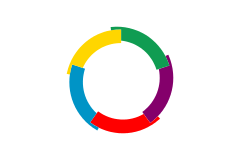Niger
Niger or the Niger[11][12] (/niːˈʒɛər/ or /ˈnaɪdʒər/;[13][14] French: [niʒɛʁ]), officially the Republic of the Niger,[11][12] is a landlocked country in West Africa named after the Niger River. Niger is bordered by Libya to the northeast, Chad to the east, Nigeria to the south, Benin to the southwest, Mali to the north-west, Burkina Faso to the south-west, and Algeria to the northwest. Niger covers a land area of almost 1,270,000 km2 (490,000 sq mi), making it the largest country in West Africa. Over 80% of its land area lies in the Sahara Desert. The country's predominantly Muslim population of about 22 million[15][16] live mostly in clusters in the far south and west of the country. The capital and largest city is Niamey, located in Niger's southwest corner.
Republic of the Niger
| |
|---|---|
Motto:
| |
.svg.png) Location of Niger (dark green) | |
| Capital and largest city | Niamey 13°32′N 2°05′E |
| Official languages | French |
| National languages[1] |
|
| Demonym(s) | Nigerien (/niːˈʒɛəriən/ [2] or /naɪˌdʒɪəriˈɛn/ [3]) |
| Government | Unitary semi-presidential republic |
| Mahamadou Issoufou | |
• Prime Minister | Brigi Rafini |
| Legislature | National Assembly |
| Independence from France | |
• Declared | 3 August 1960 |
| Area | |
• Total | 1,267,000 km2 (489,000 sq mi) (21st) |
• Water (%) | 0.02 |
| Population | |
• 2018 estimate | 22,442,831 (57th) |
• 2012 census | 17,138,707 |
• Density | 12.1/km2 (31.3/sq mi) |
| GDP (PPP) | 2018 estimate |
• Total | $23.475 billion[4] (140th) |
• Per capita | $1,213[5] (183rd) |
| GDP (nominal) | 2018 estimate |
• Total | $9.869 billion[6] (136th) |
• Per capita | $510[7] (179th) |
| Gini (2014) | medium · 70th |
| HDI (2018) | low · 189th |
| Currency | West African CFA franc (XOF) |
| Time zone | UTC+1 (WAT) |
| Driving side | right[10] |
| Calling code | +227 |
| ISO 3166 code | NE |
| Internet TLD | .ne |
| |
Niger is a developing country, which consistently ranks near the bottom in the United Nations' Human Development Index (HDI); it was ranked 187th of 188 countries for 2015 and 189th out of 189 countries in the 2018 and 2019 reports.[17] Many of the non-desert portions of the country are threatened by periodic drought and desertification. The economy is concentrated around subsistence, with some export agriculture in the more fertile south, and export of raw materials, especially uranium ore. Niger faces serious challenges to development due to its landlocked position, desert terrain, inefficient agriculture, high fertility rates without birth control, and the resulting overpopulation,[18] the poor educational level and poverty of its people, lack of infrastructure, poor healthcare, and environmental degradation.
Nigerien society reflects a diversity drawn from the long independent histories of its several ethnic groups and regions and their relatively short period living in a single state. Historically, what is now Niger has been on the fringes of several large states. Since independence, Nigeriens have lived under five constitutions and three periods of military rule. After the military coup in 2010, Niger became a democratic, multi-party state. A majority of the population lives in rural areas and has little access to advanced education.
Etymology
The country's name comes from the Niger river which flows through the west of the country; the origin of the river's name is uncertain, though a popular theory is that it comes from the Tuareg n'eghirren, meaning 'flowing water'.[19] The most common pronunciation is the French one of /niːˈʒɛər/, though in Anglophone media /ˈnaɪdʒər/ is also occasionally used.
History
Prehistory

Humans have inhabited the territory of modern Niger for millennia; stone tools, some dating as far back as 280,000 BC, have been found in Adrar Bous, Bilma and Djado in the northern Agadez Region.[20] Some of these finds have been linked with the Aterian and Mousterian tool cultures of the Middle Paleolithic period, which flourished in northern Africa circa 90,000 BC-20,000 BC.[21][20] It is thought that these early humans lived a hunter-gatherer lifestyle.[20] In prehistoric times the climate of the Sahara desert was much wetter and more fertile than it is today, a phenomenon archaeologists refer to as the 'Green Sahara', which provided favourable conditions for hunting and later agriculture and livestock herding.[22][23]
The Neolithic era began circa 10,000 BC; this period saw a number of important changes, such as the introduction of pottery (as evidenced at Tagalagal, Temet and Tin Ouffadene), the spread of cattle husbandry, and the burying of the dead in stone tumuli.[20] As the climate changed in the period 4000–2800 BC the Sahara gradually began drying out, forcing a change in settlement patterns to the south and east.[24] Agriculture became widespread, notably the planting of millet and sorghum, as well as pottery production.[20] Iron and copper items first appear in this era, with early find including those at Azawagh, Takedda, Marendet and the Termit Massif.[25][26][27] The Kiffian (circa 8000–6000 BC) and later Tenerian (circa 5000–2500 BC) cultures, centred on Adrar Bous and Gobero where numerous skeletons have been uncovered, flourished during this period.[28][28][29][30][31][32]
Towards the end of this period, up till the first centuries AD, societies continued to grow and become more complex, with regional differentiation in agricultural and funerary practices. A notable culture of this late period is the Bura culture (circa 200–1300 AD), named for the Bura archaeological site. where a burial replete with many iron and ceramic statuettes were discovered.[33] The Neolithic era also saw the flourishing of Saharan rock art, most notably in the Aïr Mountains, Termit Massif, Djado Plateau, Iwelene, Arakao, Tamakon, Tzerzait, Iferouane, Mammanet and Dabous; the art spans the period from 10,000BC to 100AD and depicts a range of subjects, from the varied fauna of the landscape to depictions of spear-carrying figures dubbed 'Libyan warriors'.[34][35][36]
Empires and kingdoms in pre-colonial Niger
Our knowledge of early Nigerien history is limited by the lack of written sources, though it is known that by at least the 5th century BC the territory of modern Niger had become an area of trans-Saharan trade. Led by Tuareg tribes from the north, camels were as a well-adapted means of transportation through what was now an immense desert.[37][38] This mobility, which would continue in waves for several centuries, was accompanied with further migration to the south and intermixing between sub-Saharan African and North African populations, as well as the gradual spread of Islam.[39] It was also aided by the Arab invasion of North Africa at the end of the 7th century, which resulted in population movements to the south.[24] Several empires and kingdoms flourished in the Sahel during this era. Their history does not fit easily within the modern boundaries of Niger, which were created during the period of European colonialism; the following adopts a roughly chronological account of the main empires.
Mali Empire (1200s–1400s)
The Mali Empire was a Mandinka empire founded by Sundiata Keita (r. 1230–1255) in circa 1230 and existed up to 1600. As detailed in the Epic of Sundiata, Mali emerged as a breakaway region of the Sosso Empire, which itself had split from the earlier Ghana Empire. Thereafter Mali defeated the Sosso at the Battle of Kirina in 1235 and then Ghana in 1240.[40][41][42] From its heartland around the modern Guinea-Mali border region, the empire expanded considerably under successive kings and came to dominate the Trans-Saharan trade routes, reaching its greatest extent during the rule of Mansa Musa (r. 1312-1337).[41] At this point parts of what are now Niger's Tillabéri Region fell under Malian rule.[40] A Muslim, Mansa Musa performed the hajj in 1324–25 and encouraged the spread of Islam in the empire, though it appears that most ordinary citizens continued to maintain their traditional animist beliefs instead of or alongside the new religion.[40][43] The empire began declining in the 15th century due to a combination of internecine strife over the royal succession, weak kings, the shift of European trade routes to the coast, and rebellions in the empire's periphery by Mossi, Wolof, Tuareg and Songhai peoples.[43] However a rump Mali kingdom continued to exist until late 1600s.[41]
Songhai Empire (1000s–1591)
The Songhai Empire was named for its main ethnic group, the Songhai or Sonrai, and was centred on the bend of the Niger River in modern Mali. Songhai began settling this region from the 7th to 9th centuries;[44] by the early 11th century Gao (capital of the former Kingdom of Gao) had become the empire's capital.[44][45][46] From 1000 to 1325, the Songhai Empire prospered and managed to maintain peace with the Mali Empire, its powerful neighbour to the west. In 1325 Songhai was conquered by Mali until regaining its independence in 1375.[44] Under king Sonni Ali (r. 1464–1492) Songhai adopted an expansionist policy which reached its apogee during the reign of Askia Mohammad I (r. 1493–1528); at this point the empire had expanded considerably from its Niger-bend heartland, including to the east where much of modern western Niger fell under its rule, including Agadez, which was conquered in 1496.[20][47][48] However the empire was unable to withstand repeated attacks from the Saadi Dynasty of Morocco and was decisively defeated at the Battle of Tondibi in 1591; the empire then collapsed into a number of smaller kingdoms.[44][46]
Sultanate of Aïr (1400s–1906)
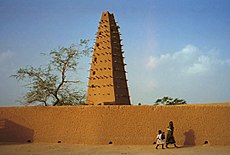
In c. 1449 in the north of what is now Niger, the Sultanate of Aïr was founded by Sultan Ilisawan, based in Agadez.[20] Formerly a small trading post inhabited by a mixture of Hausa and Tuaregs, the sultanate grew rich due to its strategic position on the Trans-Saharan trade routes. In 1515 Aïr was conquered by Songhai, remaining a part of that empire until its collapse in 1591.[20][39] The following centuries present a somewhat confused picture, though it seems that the sultanate entered a decline marked by internecine wars and clan conflicts.[39] When Europeans began exploring the region in the 19th century much of Agadez lay in ruins, and it was taken over, though with difficulty, by the French (see below).[20][39]
Kanem-Bornu Empire (700s–1700s)
To the east, the Kanem-Bornu Empire dominated the region around Lake Chad for much of this period.[46] It was founded by the Zaghawa around the 8th century and based in Njimi, north-east of the lake. The kingdom gradually expanded, especially during the rule of the Sayfawa Dynasty which began in c. 1075 under Mai (king) Hummay.[49][50] The kingdom reached its greatest extent in the 1200s, largely thanks to the effort of Mai Dunama Dibbalemi (r. 1210–1259), and grew rich from its control of many Trans-Saharan trade routes; much of eastern and south-eastern Niger, notably Bilma and Kaouar, was under Kanem's control in this period.[51] Islam had been introduced to the kingdom by Arab traders from the 11th century, gradually gaining more converts over the following centuries.[49] Attacks by the Bulala people in the late 14th century forced Kanem to shift westwards of Lake Chad, where it became known as the Bornu Empire, ruled from its capital Ngazargamu on the modern Niger-Nigeria border.[52][49][53] Bornu prospered during the rule of Mai Idris Alooma (r. circa 1575–1610) and re-conquered much of the traditional lands of Kanem, hence the designation 'Kanem-Bornu' for the empire. By the late 17th century and into the 18th the Bornu kingdom had entered a long period of decline, gradually shrinking back to its Lake Chad heartland, though it remained an important player in the region.[46][49]
Circa 1730–40 a group of Kanuri settlers led by Mallam Yunus left Kanem and founded the Sultanate of Damagaram, centred on the town of Zinder.[39] The sultanate remained nominally subject to the Borno Empire until the reign of Sultan Tanimoune Dan Souleymane in the mid-to-late 19th century, who declared independence and initiated a phase of vigorous expansion.[20] The sultanate managed to resist the advance of the Sokoto Caliphate (see below), but was later captured by the French in 1899.[20]
The Hausa states and other smaller kingdoms (1400s–1800s)
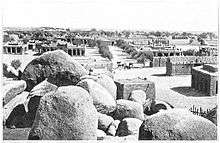
Between the Niger River and Lake Chad lay various Hausa Kingdoms kingdoms, encompassing the cultural-linguistic area known as Hausaland which straddles the modern Niger-Nigeria border.[54] The origins of the Hausa are obscure, though they are thought to be a mixture of autochthonous peoples and migrant peoples from the north and/or east, emerging as a distinct people sometime in the 900s–1400s when the kingdoms were founded.[54][20][55] They gradually adopted Islam from the 14th century, though often this existed alongside traditional religions, developing into unique syncretic forms; some Hausa groups, such as the Azna, resisted Islam altogether (the area of Dogondoutchi remains an animist stronghold to this day).[20][46] The Hausa kingdoms were not a compact entity but several federations of kingdoms more or less independent of one other. Their organisation was hierarchical though also somewhat democratic: the Hausa kings were elected by the notables of the country and could be removed by them.[45] The Hausa Kingdoms began as seven states founded, according to the Bayajidda legend, by the six sons of Bawo.[54][46] Bawo was the only son of the Hausa queen Daurama and Bayajidda or (Abu Yazid according to certain Nigerien historians) who came from Baghdad. The seven original Hausa states (often referred to as the 'Hausa bakwai') were: Daura (state of queen Daurama), Kano, Rano, Zaria, Gobir, Katsina and Biram.[45][20][55] An extension of the legend states that Bawo had a further seven sons with a concubine, who went on to the found the so-called 'Banza (illegitmate) Bakwai': Zamfara, Kebbi, Nupe, Gwari, Yauri, Ilorin and Kwararafa.[55] A smaller state not fitting into this scheme was Konni, centred on Birni-N'Konni.[39]
The Fulani (also called Peul, Fulbe etc.), a pastoral people found throughout the Sahel, began migrating to Hausaland during the 1200s–1500s.[46][54] During the later 18th century many Fulani were unhappy with the syncretic form of Islam practised there; exploiting also the populace's disdain with corruption amongst the Hausa elite, the Fulani scholar Usman Dan Fodio (from Gobir) declared a jihad in 1804.[39][20][56] After conquering most of Hausaland (though not the Bornu Kingdom, which remained independent) he proclaimed the Sokoto Caliphate in 1809.[54] Some of the Hausa states survived by fleeing south, such as the Katsina who moved to Maradi in the south of modern Niger.[46] Many of these surviving states harassed the Caliphate and a long period of small-scale wars and skirmishes commenced, with some states (such as Katsina and Gobir) maintaining independence, whereas elsewhere new ones were formed (such as the Sultanate of Tessaoua). The Caliphate managed to survive until, fatally weakened by the invasions of Chad-based warlord Rabih az-Zubayr, it finally fell to the British in 1903, with its lands later being partitioned between Britain and France.[57]
Other smaller kingdoms of the period include the Dosso Kingdom, a Zarma polity founded in 1750 which resisted the rule of Hausa and Sokoto states; and the Dendi Kingdom on the Niger river, which had been founded by refugees fleeing the collapse of the Songhai Empire in 1591.[39]
French Niger (1900–58)
In the 19th century Europeans began to take a greater interest in Africa; several European explorers travelled in the area of modern Niger, such as Mungo Park (in 1805–06), the Oudney-Denham-Clapperton expedition (1822–25), Heinrich Barth (1850–55; with James Richardson and Adolf Overweg), Friedrich Gerhard Rohlfs (1865–67), Gustav Nachtigal (1869–74) and Parfait-Louis Monteil (1890–92).[20]
Several European countries already possessed littoral colonies in Africa, and in the latter half of the century they began to turn their eyes towards the interior of the continent. This process, known as the 'Scramble for Africa', culminated in the 1885 Berlin conference in which the colonial powers outlined the division of Africa into spheres of influence. As a result of this, France gained control of the upper valley of the Niger River (roughly equivalent to the areas of modern Mali and Niger).[58] France then set about making a reality of their rule on the ground. In 1897 the French officer Marius Gabriel Cazemajou was sent to Niger; he reached the Sultanate of Damagaram in 1898 and stayed in Zinder at the court of Sultan Amadou Kouran Daga—however he was later killed as Daga feared he would ally with the Chad-based warlord Rabih az-Zubayr.[39] In 1899–1900 France coordinated three expeditions—the Gentil Mission from French Congo, the Foureau-Lamy Mission from Algeria and the Voulet–Chanoine Mission from Timbuktu—with the aim of linking France's African possessions.[58] The three eventually met at Kousséri (in the far north of Cameroon) and defeated Rabih az-Zubayr's forces at the Battle of Kousséri. The Voulet-Chanoine Mission was marred by numerous atrocities, and became notorious for pillaging, looting, raping and killing many local civilians on its passage throughout southern Niger.[39][20] On 8 May 1899, in retaliation for the resistance of queen Sarraounia, captain Voulet and his men murdered all the inhabitants of the village of Birni-N'Konni in what is regarded as one of the worst massacres in French colonial history.[39] The brutal methods of Voulet and Chanoine caused a scandal and Paris was forced to intervene; however when Lieutenant-Colonel Jean-François Klobb caught up with the mission near Tessaoua to relieve them of command he was killed. Lt. Paul Joalland, Klobb's former officer, and Lt. Octave Meynier eventually took over the mission following a mutiny in which Voulet and Chanoine were killed.[20]
The Military Territory of Niger was subsequently created within the Upper Senegal and Niger colony (modern Burkina Faso, Mali and Niger) in December 1904 with its capital at Niamey, then little more than a large village.[20] The border with Britain's colony of Nigeria to the south was finalised in 1910, a rough delimitation having already been agreed by the two powers via several treaties during the period 1898–1906.[58] The capital of the territory was moved to Zinder in 1912 when the Niger Military Territory was split off from Upper Senegal and Niger, before being moved back to Niamey in 1922 when Niger became a fully-fledged colony within French West Africa.[20][39] The borders of Niger were drawn up in various stages and had been fixed at their current position by the late 1930s. Various territorial adjustments took place in this period: the areas west of the Niger river were only attached to Niger in 1926–27, and during the dissolution of Upper Volta (modern Burkina Faso) in 1932–47 much of the east of that territory was added to Niger;[59][39] and in the east the Tibesti Mountains were transferred to Chad in 1931.[60]
The French generally adopted a form of indirect rule, allowing existing native structures to continue to exist within the colonial framework of governance providing that they acknowledged French supremacy.[20] The Zarma of the Dosso Kingdom in particular proved amenable to French rule, using them as allies against the encroachments of Hausa and other nearby states; over time the Zarma thus became one of the more educated and westernised groups in Niger.[39] However, perceived threats to French rule, such as the Kobkitanda rebellion in Dosso Region (1905–06), led by the blind cleric Alfa Saibou, and the Karma revolt in the Niger valley (December 1905–March 1906) led by Oumarou Karma were suppressed with force, as were the latter Hamallayya and Hauka religious movements.[20][39][61] Though largely successful in subduing the sedentary populations of the south, the French faced considerably more difficulty with the Tuareg in the north (centered on the Sultanate of Aïr in Agadez), and France was unable to occupy Agadez until 1906.[20] Tuareg resistance continued however, culminating in the Kaocen revolt of 1916–17, led by Ag Mohammed Wau Teguidda Kaocen, with backing from the Senussi in Fezzan; the revolt was violently suppressed and Kaocen fled to Fezzan, where he was later killed.[39] A puppet sultan was set up by the French and the decline and marginalisation of the north of the colony continued, exacerbated by a series of droughts.[39] Though it remained something of a backwater, some limited economic development took place in Niger during the colonial years, such as the introduction of groundnut cultivation.[20] Various measures to improve food security following a series of devastating famines in 1913, 1920 and 1931 were also introduced.[20][39]
During the Second World War, during which time mainland France was occupied by Nazi Germany, Charles de Gaulle issued the Brazzaville Declaration, declaring that the French colonial empire would be replaced post-war with a less centralised French Union.[62] The French Union, which lasted from 1946–58, conferred a limited form of French citizenship on the inhabitants of the colonies, with some decentralisation of power and limited participation in political life for local advisory assemblies. It was during this period that the Nigerien Progressive Party (Parti Progressiste Nigérien, or PPN, originally a branch of the African Democratic Rally, or Rassemblement Démocratique Africain – RDA) was formed under the leadership of former teacher Hamani Diori, as well as the left-wing Mouvement Socialiste Africain-Sawaba (MSA) led by Djibo Bakary. Following the Overseas Reform Act (Loi Cadre) of 23 July 1956 and the establishment of the Fifth French Republic on 4 December 1958, Niger became an autonomous state within the French Community. On 18 December 1958, an autonomous Republic of Niger was officially created under the leadership of Hamani Diori. The MSA was banned in 1959 for its perceived excessive anti-French stance.[63] On 11 July 1960, Niger decided to leave the French Community and acquired full independence on 3 August 1960; Diori thus became the first president of the country.
Independent Niger (1960–present)
Diori years (1960–74)
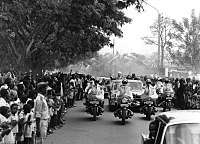
For its first 14 years as an independent state Niger was run by a single-party civilian regime under the presidency of Hamani Diori.[64] The 1960s were largely peaceful, and saw a large expansion of the education system and some limited economic development and industrialisation.[39] Links with France remained deep, with Diori allowing the development of French-led uranium mining in Arlit and supporting France in the Algerian War.[39] Relations with other African states were mostly positive, with the exception of Dahomey (Benin), owing to an ongoing border dispute. Niger remained a one-party state throughout this period, with Diori surviving a planned coup in 1963 and an assassination attempt in 1965; much of this activity was masterminded by Djibo Bakary's MSA-Sawaba group, which had launched an abortive rebellion in 1964.[39][65] In the early 1970s, a combination of economic difficulties, devastating droughts and accusations of rampant corruption and mismanagement of food supplies resulted in a coup d'état that overthrew the Diori regime.
First military regime: The Supreme Military Council and Second Republic (1974–1991)
The coup had been masterminded by Col. Seyni Kountché and a small military group under the name of the Conseil Militaire Supreme, with Kountché going on to rule the country until his death in 1987.[39] The first action of the military government was to address the food crisis.[66] Whilst political prisoners of the Diori regime were released after the coup and the country was stabilised, political and individual freedoms in general deteriorated during this period. There were several attempted coups (in 1975, 1976 and 1984) which were thwarted, their instigators being severely punished.[39]
Despite the restriction in freedom, the country enjoyed improved economic development as Kountché sought to create a 'development society', funded largely by the uranium mines in Agadez Region.[39] Several parastatal companies were created, major infrastructure (building and new roads, schools, health centres) constructed, and there was minimal corruption in government agencies, which Kountché did not hesitate to punish severely.[67] In the 1980s Kountché began cautiously loosening the grip of the military, with some relaxation of state censorship and attempts made to 'civilianise' the regime.[39] However the economic boom ended following the collapse in uranium prices, and IMF-led austerity and privatisation measures provoked opposition by many Nigerians.[39] In 1985 a small Tuareg revolt in Tchintabaraden was suppressed.[39] Kountché died in November 1987 from a brain tumour, and was succeeded by his Chief of Staff, Col. Ali Saibou, who was confirmed as Chief of the Supreme Military Council four days later.[39]
Saibou significantly curtailed the most repressive aspects of the Kountché era (such as the secret police and media censorship), and set about introducing a process of political reform under the overall direction of a single party (the Mouvement National pour la Société du Développement, or MNSD).[39] A Second Republic was declared and a new constitution was drawn up, which was adopted following a referendum in 1989.[39] General Saibou became the first president of the Second Republic after winning the presidential election on 10 December 1989.[68]
President Saibou's efforts to control political reforms failed in the face of trade union and student demands to institute a multi-party democratic system. On 9 February 1990, a violently repressed student march in Niamey led to the death of three students, which led to increased national and international pressure for further democratic reform.[39] The Saibou regime acquiesced to these demands by the end of 1990.[39] Meanwhile, trouble re-emerged in Agadez Region when a group of armed Tuaregs attacked the town of Tchintabaraden (generally seen as the start of the first Tuareg Rebellion), prompting a severe military crackdown which led to many deaths (the precise numbers are disputed, with estimates ranging from 70 to up to 1,000).[39]
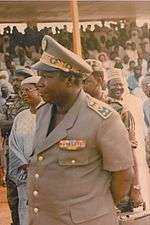
National Conference and Third Republic (1991–1996)
The National Sovereign Conference of 1991 marked a turning point in the post-independence history of Niger and brought about multi-party democracy. From 29 July to 3 November, a national conference gathered together all elements of society to make recommendations for the future direction of the country. The conference was presided over by Prof. André Salifou and developed a plan for a transitional government; this was then installed in November 1991 to manage the affairs of state until the institutions of the Third Republic were put into place in April 1993. After the National Sovereign Conference, the transitional government drafted a new constitution that eliminated the previous single-party system of the 1989 Constitution and guaranteed more freedoms. The new constitution was adopted by a referendum on 26 December 1992.[69] Following this, presidential elections were held and Mahamane Ousmane became the first president of the Third Republic on 27 March 1993.[39][68] Ousmane's presidency was characterised by political turbulence, with four government changes and early legislative elections in 1995, as well a severe economic slump which the coalition government proved unable to effectively address.[39]
The violence in Agadez Region continued during this period, prompting the Nigerien government to sign a truce with Tuareg rebels in 1992 which was however ineffective owing to internal dissension within the Tuareg ranks.[39] Another rebellion, led by dissatisfied Toubou peoples claiming that, like the Tuareg, the Nigerien government had neglected their region, broke out in the east of the country.[39] In April 1995 a peace deal with the main Tuareg rebel group was signed, with the government agreeing to absorb some former rebels into the military and, with French assistance, help others return to a productive civilian life.[70]
Second military regime, Fourth Republic and third military regime (1996–1999)
The governmental paralysis prompted the military to intervene; on 27 January 1996, Col. Ibrahim Baré Maïnassara led a coup that deposed President Ousmane and ended the Third Republic.[71][72] Maïnassara headed a Conseil de Salut National (National Salvation Council) composed of military official which carried out a six-month transition period, during which a new constitution was drafted and adopted on 12 May 1996.[39]
Presidential campaigns were organised in the months that followed. Maïnassara entered the campaign as an independent candidate and won the election on 8 July 1996, however the elections were viewed nationally and internationally as irregular, as the electoral commission was replaced during the campaign.[39] Meanwhile, Maïnassara instigated an IMF and World Bank-approved privatisation programme which enriched many of his supporters but were opposed by the trade unions.[39] Following fraudulent local elections in 1999 the opposition ceased any cooperation with the Maïnassara regime.[39] In unclear circumstance (possibly attempting to flee the country), Maïnassara was assassinated at Niamey Airport on 9 April 1999.[73][74]
Maj. Daouda Malam Wanké then took over, establishing a transitional National Reconciliation Council to oversee the drafting of a constitution with a French-style semi-presidential system. This was adopted on 9 August 1999 and was followed by presidential and legislative elections in October and November of the same year.[75] The elections were generally found to be free and fair by international observers. Wanké then withdrew from governmental affairs.[39]
Fifth Republic (1999–2009)
After winning the election in November 1999, President Tandja Mamadou was sworn in office on 22 December 1999 as the first president of the Fifth Republic. Mamadou brought about many administrative and economic reforms that had been halted due to the military coups since the Third Republic, as well as helped peacefully resolve a decades-long boundary dispute with Benin.[76][77] In August 2002, serious unrest within military camps occurred in Niamey, Diffa, and Nguigmi, but the government was able to restore order within several days. On 24 July 2004, the first municipal elections in the history of Niger were held to elect local representatives, previously appointed by the government. These elections were followed by presidential elections, in which Mamadou was re-elected for a second term, thus becoming the first president of the republic to win consecutive elections without being deposed by military coups.[39][78] The legislative and executive configuration remained quite similar to that of the first term of the President: Hama Amadou was reappointed as Prime Minister and Mahamane Ousmane, the head of the CDS party, was re-elected as the President of the National Assembly (parliament) by his peers.
By 2007, the relationship between President Tandja Mamadou and his prime minister had deteriorated, leading to the replacement of the latter in June 2007 by Seyni Oumarou following a successful vote of no confidence at the Assembly.[39] The political environment worsened in the following year as President Tandja Mamadou sought out to extend his presidency by modifying the constitution which limited presidential terms in Niger. Proponents of the extended presidency, rallied behind the 'Tazartche' (Hausa for 'overstay') movement, were countered by opponents ('anti-Tazartche') composed of opposition party militants and civil society activists.[39]
The situation in the north also deteriorated significantly in this period, resulting in the outbreak of a Second Tuareg Rebellion in 2007 led by the Mouvement des Nigériens pour la justice (MNJ). Despite a number of high-profile kidnappings the rebellion had largely fizzled out inconclusively by 2009.[39] However the poor security situation in the region is thought to have allowed elements of Al-Qaeda in the Islamic Maghreb (AQIM) to gain a foothold in the country.[39]
Sixth Republic and fourth military regime (2009–2010)
In 2009, President Tandja Mamadou decided to organize a constitutional referendum seeking to extend his presidency, which was opposed by other political parties, as well as being against the decision of the Constitutional Court which had ruled that the referendum would be unconstitutional. Mamadou then modified and adopted a new constitution by referendum, which was declared illegal by the Constitutional Court, prompting Mamadou to dissolve the Court and assume emergency powers.[79][80] The opposition boycotted the referendum and the new constitution was adopted with 92.5% of voters and a 68% turnout, according to official results. The adoption of the new constitution created a Sixth Republic, with a presidential system, as well as the suspension of the 1999 Constitution and a three-year interim government with Tandja Mamadou as president. The events generated severe political and social unrest throughout the country.[39]
In a coup d'état in February 2010, a military junta led by captain Salou Djibo was established in response to Tandja's attempted extension of his political term by modifying the constitution.[81] The Supreme Council for the Restoration of Democracy, led by General Salou Djibo, carried out a one-year transition plan, drafted a new constitution and held elections in 2011 that were judged internationally as free and fair.
Seventh Republic (2010–present)
Following the adoption of a new constitution in 2010 and presidential elections a year later, Mahamadou Issoufou was elected as the first president of the Seventh Republic; he was then re-elected in 2016.[82][39] An attempted coup against him in 2011 was thwarted and its ringleaders arrested.[83] Issoufou's time in office has been marked by numerous threats to the country's security, stemming from the fallout from the Libyan Civil War and Northern Mali conflict, a rise in attacks by AQIM, the use of Niger as a transit country for migrants (often organised by criminal gangs), and the spillover of Nigeria's Boko Haram insurgency into south-eastern Niger.[84] French and American forces are currently assisting Niger in countering these threats.[85]
Geography, climate, and ecology
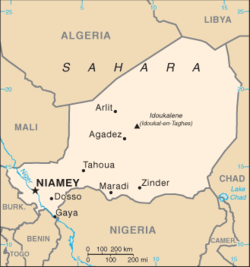
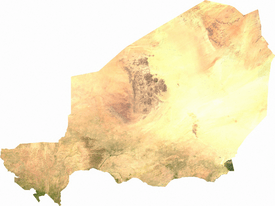
Niger is a landlocked nation in West Africa located along the border between the Sahara and Sub-Saharan regions. It borders Nigeria and Benin to the south, Burkina Faso and Mali to the west, Algeria and Libya to the north and Chad to the east.
Niger lies between latitudes 11° and 24°N, and longitudes 0° and 16°E. Niger's area is 1,267,000 square kilometres (489,191 sq mi) of which 300 square kilometres (116 sq mi) is water. This makes it slightly less than twice the size of France, and the world's twenty-second largest country.[86]
Niger borders seven countries and has a total perimeter of 5,697 kilometres (3,540 mi). The longest border is with Nigeria to the south (1,497 km or 930 mi). This is followed by Chad to the east, at 1,175 km (730 mi), Algeria to the north-northwest (956 km or 594 mi), and Mali at 821 km (510 mi). Niger also has small borders in its far southwest with Burkina Faso at 628 km (390 mi) and Benin at 266 km (165 mi) and to the north-northeast Libya at 354 km (220 mi).
The lowest point is the Niger River, with an elevation of 200 metres (656 ft). The highest point is Mont Idoukal-n-Taghès in the Aïr Mountains at 2,022 m (6,634 ft).
Climate

Niger's subtropical climate is mainly very hot and very dry, with much desert area. In the extreme south there is a tropical climate on the edges of the Niger River basin. The terrain is predominantly desert plains and sand dunes, with flat to rolling savanna in the south and hills in the north.
Environment

The north of Niger is covered by large deserts and semi deserts. The typical mammal fauna consists of Addax antelopes, Scimitar-horned oryx, gazelles and in mountains Barbary sheep. One of the largest reserves of the world, the Aïr and Ténéré National Nature Reserve, was founded in the northern parts of the Niger to protect these rare species.
The southern parts of Niger are naturally dominated savannahs. The W National Park, situated in the bordering area to Burkina Faso and Benin, belongs to one of the most important areas for wildlife in Western Africa, which is called the WAP (W–Arli–Pendjari) Complex. It has the most important population of the rare West African lion and one of the last populations of the Northwest African cheetah.
Other wildlife includes elephants, buffaloes, roan antelopes, kob antelopes and warthogs. The West African giraffe is currently not found in the W National Park, but further north in Niger, where it has its last relict population.
Environmental issues in Niger include destructive farming practices as a result of population pressure. Illegal hunting, bush fires in some areas and human encroachment upon the flood plains of the Niger River for paddy cultivation are environmental issues. Dams constructed on the Niger River in the neighboring countries of Mali and Guinea and also within Niger itself are also cited as a reason for a reduction of water flow in the Niger River—which has a direct effect upon the environment. A lack of adequate staff to guard wildlife in the parks and reserves is another factor cited for loss of wildlife.[87]
Governance and politics
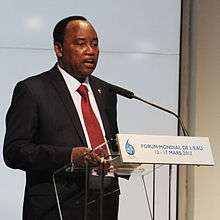
Niger's new constitution was approved on 31 October 2010. It restored the semi-presidential system of government of the 1999 constitution (Fifth Republic) in which the president of the republic, elected by universal suffrage for a five-year term, and a prime minister named by the president share executive power.
As a reflection of Niger's increasing population, the unicameral National Assembly was expanded in 2004 to 113 deputies elected for a five-year term under a majority system of representation. Political parties must attain at least 5 percent of the vote in order to gain a seat in the legislature.
The constitution also provides for the popular election of municipal and local officials, and the first-ever successful municipal elections took place on 24 July 2004. The National Assembly passed in June 2002 a series of decentralization bills. As a first step, administrative powers will be distributed among 265 communes (local councils); in later stages, regions and departments will be established as decentralized entities. A new electoral code was adopted to reflect the decentralization context. The country is currently divided into 8 regions, which are subdivided into 36 districts (departments). The chief administrator (Governor) in each department is appointed by the government and functions primarily as the local agent of the central authorities.
On 26 May 2009, President Tandja dissolved parliament after the country's constitutional court ruled against plans to hold a referendum on whether to allow him a third term in office. According to the constitution, a new parliament was elected within three months.[88] This began a political struggle between Tandja, trying to extend his term-limited authority beyond 2009 through the establishment of a Sixth Republic, and his opponents who demanded that he step down at the end of his second term in December 2009. See 2009 Nigerien constitutional crisis. The military took over the country and President Tandja was put in prison, charged with corruption.
The military kept their promise to return the country to democratic civilian rule. A constitutional referendum and national elections were held. A presidential election was held on 31 January 2011, but as no clear winner emerged, run-off elections were held on 12 March 2011. Mahamadou Issoufou of the Nigerien Party for Democracy and Socialism was elected president. A parliamentary election was held at the same time.[89][90][91]
Foreign relations
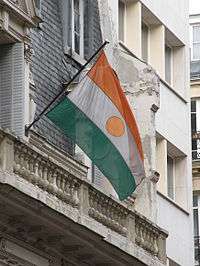
Niger pursues a moderate foreign policy and maintains friendly relations with the West and the Islamic world as well as non-aligned countries. It belongs to the UN and its main specialized agencies and in 1980–81 served on the UN Security Council. Niger maintains a special relationship with former colonial power France and has close relations with its West African neighbors.
It is a charter member of the African Union and the West African Monetary Union and also belongs to the Niger Basin Authority and Lake Chad Basin Commission, the Economic Community of West African States, the Non-Aligned Movement, the Organisation of Islamic Cooperation and the Organization for the Harmonization of Business Law in Africa (OHADA). The westernmost regions of Niger are joined with contiguous regions of Mali and Burkina Faso under the Liptako-Gourma Authority.
The border dispute with Benin, inherited from colonial times and concerning inter alia Lété Island in the Niger River, was solved by the International Court of Justice in 2005 to Niger's advantage.
Government finance
Government finance is derived revenue exports (Mining, oil and agricultural exports) as well as various forms of taxes collected by the government. In the past, foreign aid has contributed to large percentages of the budget. In 2013, Niger's government has adopted a zero-deficit budget of 1.279 trillion CFA francs ($2.53 billion) which is claimed to balance revenues and expenditures by an 11% reduction in the budget from the previous year.[92]
The 2014 budget was 1.867 trillion CFA which is distributed as follows according to: public debt (76,703,692,000 CFA), personnel expenditures (210,979,633,960 CFA), operating expenditures (128,988,777,711 CFA); subsidies and transfers: 308,379,641,366 CFA) and Investment (1,142,513,658,712 CFA).[93]
Foreign aid
The importance of external support for Niger's development is demonstrated by the fact that about 45% of the government's FY 2002 budget, including 80% of its capital budget, derives from donor resources.[94] The most important donors in Niger are France, the European Union, the World Bank, the International Monetary Fund, and various United Nations agencies (UNDP, UNICEF, FAO, World Food Program, and United Nations Population Fund).
Other principal donors include the United States, Belgium, Germany, Switzerland, Canada, and Saudi Arabia. While USAID does not have an office in Niger, the United States is a major donor, contributing nearly $10 million each year to Niger's development. The U.S. also is a major partner in policy coordination in such areas as food security and HIV/AIDS.
Judicial system
The current Judiciary of Niger was established with the creation of the Fourth Republic in 1999. The constitution of December 1992 was revised by national referendum on 12 May 1996 and, again, by referendum, revised to the current version on 18 July 1999. It is based on the Code Napoleon "Inquisitorial system", established in Niger during French colonial rule and the 1960 Constitution of Niger. The Court of Appeals reviews questions of fact and law, while the Supreme Court reviews application of the law and constitutional questions. The High Court of Justice (HCJ) deals with cases involving senior government officials. The justice system also includes civil criminal courts, customary courts, traditional mediation, and a military court.[95] The military court provides the same rights as civil criminal courts; however, customary courts do not. The military court cannot try civilians.[96]
Law enforcement
Law enforcement in Niger is the responsibility of the Ministry of Defense through the National Gendarmerie and the Ministry of the Interior through the National Police and the National Guard. The National Police is primarily responsible for law enforcement in urban areas. Outside big cities and in rural areas, this responsibility falls on the National Gendarmerie and the National Guard.
Military
The Niger Armed Forces (Forces armées nigériennes) are the military and paramilitary forces of Niger, under the president as supreme commander. They consist of the Niger Army (Armée de Terre), the Niger Air Force (Armée de l'Air) and the auxiliary paramilitary forces, such as the National Gendarmerie (Gendarmerie nationale) and the National Guard (Garde Nationale). Both paramilitary forces are trained in military fashion and have some military responsibilities in wartime. In peace time their duties are mostly policing duties.
The armed forces are composed of approximately 12,900 personnel, including 3,700 gendarmes, 3200 national guards, 300 air force personnel, and 6,000 army personnel. The armed forces of Niger have been involved several military coups over the years with the most recent in 2010. Niger's armed forces have a long history of military cooperation with France and the United States. As of 2013, Niamey is home to a U.S. drone base.
Administrative divisions
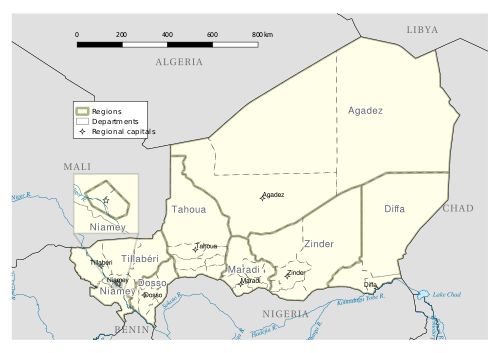
Niger is divided into 7 Regions and one capital district. These Regions are subdivided into 36 departments. The 36 Departments are currently broken down into Communes of varying types. As of 2006 there were 265 communes, including communes urbaines (Urban Communes: as subdivisions of major cities), communes rurales (Rural Communes), in sparsely populated areas and postes administratifs (Administrative Posts) for largely uninhabited desert areas or military zones.
Rural communes may contain official villages and settlements, while Urban Communes are divided into quarters. Niger subvisions were renamed in 2002, in the implementation of a decentralisation project, first begun in 1998. Previously, Niger was divided into 7 Departments, 36 Arrondissements, and Communes. These subdivisions were administered by officials appointed by the national government. These offices will be replaced in the future by democratically elected councils at each level.
The pre-2002 departments (renamed as regions) and capital district are:
- Agadez Region
- Diffa Region
- Dosso Region
- Maradi Region
- Tahoua Region
- Tillabéri Region
- Zinder Region
- Niamey (capital district)
Largest cities and towns
Economy

The economy of Niger centers on subsistence crops, livestock, and some of the world's largest uranium deposits. Drought cycles, desertification, a 2.9% population growth rate, and the drop in world demand for uranium have undercut the economy.
Niger shares a common currency, the CFA franc, and a common central bank, the Central Bank of West African States (BCEAO), with seven other members of the West African Monetary Union. Niger is also a member of the Organization for the Harmonization of Business Law in Africa (OHADA).[98]
In December 2000, Niger qualified for enhanced debt relief under the International Monetary Fund program for Heavily Indebted Poor Countries (HIPC) and concluded an agreement with the Fund for Poverty Reduction and Growth Facility (PRGF). Debt relief provided under the enhanced HIPC initiative significantly reduces Niger's annual debt service obligations, freeing funds for expenditures on basic health care, primary education, HIV/AIDS prevention, rural infrastructure, and other programs geared at poverty reduction.
In December 2005, it was announced that Niger had received 100% multilateral debt relief from the IMF, which translates into the forgiveness of approximately US$86 million in debts to the IMF, excluding the remaining assistance under HIPC. Nearly half of the government's budget is derived from foreign donor resources. Future growth may be sustained by exploitation of oil, gold, coal, and other mineral resources. Uranium prices have recovered somewhat in the last few years. A drought and locust infestation in 2005 led to food shortages for as many as 2.5 million Nigeriens.
Society
Demographics
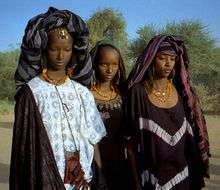
As of 2018, the population of Niger was 22,442,831[15][16]. Expanding from a population of 3.4 million in 1960, Niger's population has rapidly increased with a current growth rate of 3.3% (7.1 children per mother).[99][100]
This growth rate is one of the highest in the world and is a source of concern for the government and international agencies.[101] The population is predominantly young, with 49.2% under 15 years old and 2.7% over 65 years, and predominantly rural with only 21% living in urban areas.[99]
A 2005 study stated that over 800,000 people (nearly 8% of the population) in Niger are enslaved.[102][103][104]
Urban Settlements
| Cities of Niger | |||||
| Order | City | Population | Region | ||
| 2001 Census[105] | 2012 Census[105] | ||||
| 1. | Niamey | 690,286 | 978,029 | Niamey | |
| 2. | Maradi | 148,017 | 267,249 | Maradi Region | |
| 3. | Zinder | 170,575 | 235,605 | Zinder Region | |
| 4. | Tahoua | 73,002 | 117,826 | Tahoua Region | |
| 5. | Agadez | 77,060 | 110,497 | Agadez Region | |
| 6. | Arlit | 68,835 | 78,651 | Agadez Region | |
| 7. | Birni N'Konni | 44,663 | 63,169 | Tahoua Region | |
| 8. | Dosso | 43,561 | 58,671 | Dosso Region | |
| 9. | Gaya | 28,385 | 45,465 | Dosso Region | |
| 10. | Tessaoua | 31,667 | 43,409 | Maradi Region | |
Ethnic groups
Niger has a wide variety of ethnic groups as in most West African countries. The ethnic makeup of Niger in 2001 is as follows: Hausa (55.4%), Zarma-Songhai (21%), Tuareg (9.3%), Fula (French: Peuls; Fula: Fulɓe) (8.5%), Kanuri Manga (4.7%), Tubu (0.4%), Arab (0.4%), Gourmantche (0.4%), other (0.1%).[99] The Zarma-Songhai dominate the Dosso, Tillabéri, and Niamey régions, the Hausa dominate the Zinder, Maradi, and Tahoua regions, Kanuri Manga dominate the Diffa region, and Touaregs dominate the Agadez region in Northern Niger.[106]
Languages
French, inherited from the colonial period, is the official language. It is spoken mainly as a second language by people who have received a formal western education and serves as the administrative language. Niger has been a member of the Organisation Internationale de la Francophonie since 1970.
Niger has ten recognized national languages, namely Arabic, Buduma, Fulfulde, Gourmanchéma, Hausa, Kanuri, Zarma & Songhai, Tamasheq, Tassawaq, Tebu.[1] Each is spoken as a first language primarily by the ethnic group with which it is associated.[107][108] Hausa and Zarma-Songhai, the two most spoken languages, are widely spoken throughout the country as first or second languages.
Religion
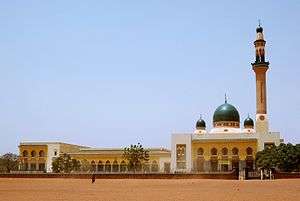
Niger is a secular country and separation of state and religion is guaranteed by Articles 3 and 175 of the 2010 Constitution, which dictate that future amendments or revisions may not modify the secular nature of the republic of Niger. Religious freedom is protected by Article 30 of the same constitution. Islam, widespread in the region since the 10th century, has greatly shaped the culture and mores of the people of Niger. Islam is the most dominant religion, practiced by 99.3% of the population according to the 2012 census.[109]
The other two main religions of Niger are Christianity, practiced by 0.3% of the population, and Animism (traditional indigenous religious beliefs), practiced by 0.2% of the population.[109] Christianity was established earlier in the country by missionaries during the French colonial years. Other urban Christian expatriate communities from Europe and West Africa are also presented. Religious persecution is rare in Niger which is ranked last (#50) on the World Watch List for severity of persecution that Christians face for actively pursuing their faith.
The numbers of Animist practitioners are a point of contention. As recently as the late 19th century, much of the south center of the nation was unreached by Islam, and the conversion of some rural areas has been only partial. There are still areas where animist based festivals and traditions (such as the Bori religion) are practiced by syncretic Muslim communities (in some Hausa areas as well as among some Toubou and Wodaabe pastoralists), as opposed to several small communities who maintain their pre-Islamic religion. These include the Hausa-speaking Maouri (or Azna, the Hausa word for "pagan") community in Dogondoutci in the south-southwest and the Kanuri speaking Manga near Zinder, both of whom practice variations of the pre-Islamic Hausa Maguzawa religion. There are also some tiny Boudouma and Songhay animist communities in the southwest.[110]
Islam
The majority of Muslims in Niger are Sunni, 7% are Shi'a, 5% are Ahmadiyya and 20% non-denominational.[111][112] Islam was spread into what is now Niger beginning in the 15th century, by both the expansion of the Songhai Empire in the west, and the influence of the Trans-Saharan trade traveling from the Maghreb and Egypt. Tuareg expansion from the north, culminating in their seizure of the far eastern oases from the Kanem-Bornu Empire in the 17th centuries, spread distinctively Berber practices.
%2C_street_scene_with_mosque.jpg)
Both Zarma and Hausa areas were greatly influenced by the 18th- and 19th-century Fula led Sufi brotherhoods, most notably the Sokoto Caliphate (in today's Nigeria). Modern Muslim practice in Niger is often tied to the Tijaniya Sufi brotherhoods, although there are small minority groups tied to Hammallism and Nyassist Sufi orders in the west, and the Sanusiya in the far northeast.[110]
A small center of followers of Salafi movement within Sunni Islam have appeared in the last thirty years, in the capital and in Maradi.[113] These small groups, linked to similar groups in Jos, Nigeria, came to public prominence in the 1990s during a series of religious riots.[114][115][116]
Despite this, Niger maintains a tradition as a secular state, protected by law.[117] Interfaith relations are deemed very good, and the forms of Islam traditionally practiced in most of the country are marked by tolerance of other faiths and lack of restrictions on personal freedom.[118] Divorce and polygyny are unremarkable, women are not secluded, and head coverings are not mandatory—they are often a rarity in urban areas.[119] Alcohol, such as the locally produced Bière Niger, is sold openly in most of the country.
Education
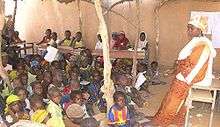
The literacy rate of Niger is among the lowest in the world; in 2005 it was estimated to be only 28.7% (42.9% male and 15.1% female).[120] Primary education in Niger is compulsory for six years.[121] The primary school enrollment and attendance rates are low, particularly for girls.[121] In 1997, the gross primary enrollment rate was 29.3 percent, and in 1996, the net primary enrollment rate was 24.5 percent.[121]
About 60 percent of children who finish primary schools are boys, as the majority of girls rarely attend school for more than a few years.[121] Children are often forced to work rather than attend school, particularly during planting or harvest periods.[121] Nomadic children in the north of the country often do not have access to schools.[121]
Health
The child mortality rate in Niger (deaths among children between the ages of 1 and 4) is high (248 per 1,000) due to generally poor health conditions and inadequate nutrition for most of the country's children. According to the organization Save the Children, Niger has the world's highest infant mortality rate.[122]
Niger also has the highest fertility rate in the world (6.49 births per woman according to 2017 estimates[123]); this means that nearly half (49%) of the Nigerien population is under age 15. Niger has the 11th highest maternal mortality rate in the world at 820 deaths/100,000 live births.[124] There were 3 physicians and 22 nurses per 100,000 persons in 2006.[125]
Culture
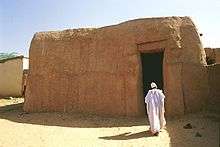
Nigerien culture is marked by variation, evidence of the cultural crossroads which French colonialism formed into a unified state from the beginning of the 20th century. What is now Niger was created from four distinct cultural areas in the pre-colonial era: the Zarma dominated Niger River valley in the southwest; the northern periphery of Hausaland, made mostly of those states which had resisted the Sokoto Caliphate, and ranged along the long southern border with Nigeria; the Lake Chad basin and Kaouar in the far east, populated by Kanuri farmers and Toubou pastoralists who had once been part of the Kanem-Bornu Empire; and the Tuareg nomads of the Aïr Mountains and Saharan desert in the vast north.
Each of these communities, along with smaller ethnic groups like the pastoral Wodaabe Fula, brought their own cultural traditions to the new state of Niger. While successive post-independence governments have tried to forge a shared national culture, this has been slow forming, in part because the major Nigerien communities have their own cultural histories, and in part because Nigerien ethnic groups such as the Hausa, Tuareg and Kanuri are but part of larger ethnic communities which cross borders introduced under colonialism.
Until the 1990s, government and politics was inordinately dominated by Niamey and the Zarma people of the surrounding region. At the same time the plurality of the population, in the Hausa borderlands between Birni-N'Konni and Maine-Soroa, have often looked culturally more to Hausaland in Nigeria than Niamey. Between 1996 and 2003, primary school attendance was around 30%,[126] including 36% of males and only 25% of females. Additional education occurs through madrasas.
Festivals and cultural events
Guérewol festival

The Guérewol festival is a traditional Wodaabe cultural event that takes place in Abalak in Tahoua region or In'Gall in Agadez Region. It is an annual traditional courtship ritual practiced by the Wodaabe (Fula) people of Niger. During this ceremony, young men dressed in elaborate ornamentation and made up in traditional face painting gather in lines to dance and sing, vying for the attention of marriageable young women. The Guérewol festival is an international attraction and was featured in films and magazines as prominent as the National Geographic.
Cure Salée festival
"La Cure salée" (English: Salt Cure) is a yearly festival of Tuareg and Wodaabe nomads in In'Gall in Agadez Region traditionally to celebrate the end of the rainy season. For three days, the festival features a parade of Tuareg camel riders followed with camel and horse races, songs, dances, and storytelling.
Media
Niger began developing diverse media in the late 1990s. Prior to the Third Republic, Nigeriens only had access to tightly controlled state media.[127] Now Niamey contains scores of newspapers and magazines; some, like Le Sahel, are government operated, while many are critical of the government.[128][129] Radio is the most important medium, as television sets are beyond the buying power of many of the rural poor, and illiteracy prevents print media from becoming a mass medium.[87]
In addition to the national and regional radio services of the state broadcaster ORTN, there are four privately owned radio networks which total more than 100 stations. Three of them—the Anfani Group, Sarounia and Tenere—are urban-based commercial-format FM networks in the major towns.[130] There is also a network of over 80 community radio stations spread across all seven regions of the country, governed by the Comité de Pilotage de Radios de Proximité (CPRP), a civil society organisation. The independent-sector radio networks are collectively estimated by CPRP officials to cover some 7.6 million people, or about 73% of the population (2005).
Aside from Nigerien radio stations, the BBC's Hausa service is listened to on FM repeaters across wide parts of the country, particularly in the south, close to the border with Nigeria. Radio France Internationale also rebroadcasts in French through some of the commercial stations, via satellite. Tenere FM also runs a national independent television station of the same name.[130]
Despite relative freedom at the national level, Nigerien journalists say they are often pressured by local authorities.[131] The state ORTN network depends financially on the government, partly through a surcharge on electricity bills, and partly through direct subsidy. The sector is governed by the Conseil Supérieur de Communications, established as an independent body in the early 1990s, since 2007 headed by Daouda Diallo. International human rights groups have criticised the government since at least 1996 as using regulation and police to punish criticism of the state.[132][133]
See also
References
- République du Niger, "Loi n° 2001-037 du 31 décembre 2001 fixant les modalités de promotion et de développement des langues nationales." L'aménagement linguistique dans le monde Archived 19 October 2018 at the Wayback Machine (accessed 21 September 2016)
- "Nigerien – definition of Nigerien in English from the Oxford Dictionaries". Archived from the original on 1 March 2018. Retrieved 1 March 2018.
- "Niger." The American Heritage® Dictionary of the English Language, Fourth Edition. 2003. Houghton Mifflin Company 22 February 2013 http://www.thefreedictionary.com/Niger Archived 12 May 2013 at the Wayback Machine
- "Report for Selected Country Groups and Subjects (PPP valuation of country GDP)". IMF. Retrieved 14 November 2018.
- World Economic Outlook Database, January 2018 Archived 3 May 2018 at the Wayback Machine, International Monetary Fund Archived 14 February 2006 at Archive-It. Database updated on 12 April 2017. Accessed on 21 April 2017.
- "World Economic Outlook Database. Report for Selected Countries and Subjects". International Monetary Fund. 17 April 2018.
- World Economic Outlook Database, April 2018 Archived 26 April 2018 at the Wayback Machine, International Monetary Fund. Accessed on 17 April 2018.
- World Bank GINI index Archived 9 February 2015 at the Wayback Machine, accessed on 21 January 2016.
- "Human Development Report 2019" (PDF). United Nations Development Programme. 10 December 2019. Archived (PDF) from the original on 22 March 2017. Retrieved 10 December 2019.
- Which side of the road do they drive on? Archived 14 April 2012 at the Wayback Machine Brian Lucas. August 2005. Retrieved 28 January 2009.
- "ISO 3166". ISO Online Browsing Platform. Archived from the original on 17 June 2016. Retrieved 12 May 2017.
- "UNGEGN World Geographical Names". United Nations Statisticsc Division. 1 March 2017. Archived from the original on 28 July 2011. Retrieved 12 May 2017.
- How Do You Pronounce "Niger"? Archived 14 March 2012 at the Wayback Machine from Slate.com, retrieved 4 March 2012
- "Niger." The American Heritage® Dictionary of the English Language, Fourth Edition. 2003. Houghton Mifflin Company 22 February 2013 thefreedictionary.com/Niger Archived 12 May 2013 at the Wayback Machine
- ""World Population prospects – Population division"". population.un.org. United Nations Department of Economic and Social Affairs, Population Division. Retrieved 9 November 2019.
- ""Overall total population" – World Population Prospects: The 2019 Revision" (xslx). population.un.org (custom data acquired via website). United Nations Department of Economic and Social Affairs, Population Division. Retrieved 9 November 2019.
- "Latest Human Development Index (HDI) Ranking (2018)". hdr.undp.org. UNITED NATIONS DEVELOPMENT PROGRAMME. Archived from the original on 18 November 2018. Retrieved 21 September 2018.
- "Population Explosion". The Economist. 16 August 2014. Archived from the original on 29 July 2015. Retrieved 3 August 2015.
- Atlas A-Z. New York City: Dorling Kindersley. 2004. p. 289.
- Geels, Jolijn, (2006) Bradt Travel Guide - Niger, pgs. 15-22
- Dibble, Harold L.; Aldeias, Vera; Jacobs, Zenobia; Olszewski, Deborah I.; Rezek, Zeljko; Lin, Sam C.; Alvarez-Fernández, Esteban; Barshay-Szmidt, Carolyn C.; Hallett-Desguez, Emily (1 March 2013). "On the industrial attributions of the Aterian and Mousterian of the Maghreb". Journal of Human Evolution. 64 (3): 194–210. doi:10.1016/j.jhevol.2012.10.010. PMID 23399349.
- Gwin, Peter. "Lost Tribes of the Green Sahara" Archived 3 September 2010 at the Wayback Machine, National Geographic, September 2008.
- Oliver, Roland (1999), The African Experience: From Olduvai Gorge to the 21st Century (Series: History of Civilization), London: Phoenix Press, revised edition, pg 39.
- (in French) Niger Archived 2 July 2014 at the Wayback Machine. Encyclopédie Larousse
- Duncan E. Miller and N.J. Van Der Merwe, 'Early Metal Working in Sub Saharan Africa' Journal of African History 35 (1994) 1–36; Minze Stuiver and N.J. Van Der Merwe, 'Radiocarbon Chronology of the Iron Age in Sub-Saharan Africa' Current Anthropology 1968.
- Grébénart, Danilo (1993), "Azelik Takedda et le cuivre médiéval dans la région d'Agadez", Le Saharien (Paris), 125 (2): 28–33, archived from the original on 24 July 2018, retrieved 12 November 2019
- Iron in Africa: Revisiting the History Archived 25 October 2008 at the Wayback Machine – Unesco (2002)
- Ancient cemetery found in 'green' Sahara Desert Archived 11 August 2014 at the Wayback Machine. By Randolph E. Schmid. Associated Press /ABC News.
- Clark, J. Desmond; Gifford-Gonzalez, Diane (2008). Adrar Bous: archaeology of a central Saharan granitic ring complex in Niger. Royal Museum of Central Africa, Tervuren.
- "Stone Age Graveyard Reveals Lifestyles Of A 'Green Sahara'". Science Daily. 15 August 2008. Archived from the original on 16 August 2008. Retrieved 15 August 2008.
- Wilford, John Noble (14 August 2008). "Graves Found From Sahara's Green Period". New York Times. Archived from the original on 23 January 2012. Retrieved 15 August 2008.
- Sereno PC, Garcea EAA, Jousse H, Stojanowski CM, Saliège J-F, Maga A, et al. (2008). "Lakeside Cemeteries in the Sahara: 5000 Years of Holocene Population and Environmental Change". PLOS One. 3 (8): e2995. Bibcode:2008PLoSO...3.2995S. doi:10.1371/journal.pone.0002995. PMC 2515196. PMID 18701936.
- Centre, UNESCO World Heritage. "Site archéologique de Bura". UNESCO World Heritage Centre. Archived from the original on 10 December 2019. Retrieved 7 April 2020.
- African Rock Art - Niger, British Museum, archived from the original on 2 July 2019, retrieved 11 November 2019
- Caulson, David, Sub-Zone 3: Niger (PDF), ICOMOS, archived (PDF) from the original on 12 December 2018, retrieved 11 November 2019
- Shillington, Kevin (1989, 1995). History of Africa, Second Edition. St. Martin's Press, New York. Page 32.
- Lewicki, T. (1994). "The Role of the Sahara and Saharians in Relationships between North and South". In UNESCO General History of Africa: Volume 3. University of California Press, ISBN 92-3-601709-6.
- Masonen, P: "Trans-Saharan Trade and the West African Discovery of the Mediterranean World. Archived 8 October 2006 at the Wayback Machine"
- Decalo, Sameul & Idrissa, Abdourahmane (1 June 2012). Historical Dictionary of Niger. ISBN 9780810870901. Archived from the original on 25 July 2018. Retrieved 25 July 2018.CS1 maint: uses authors parameter (link)
- Sirio Canós-Donnay (February 2019). "Mali Empire". Oxford Research Encyclopedias. doi:10.1093/acrefore/9780190277734.013.266. Archived from the original on 30 July 2019. Retrieved 13 November 2019.
- "Mali Empire: The Rise of the Richest Civilization in West Africa". Ancient History Encyclopedia. 4 April 2019. Archived from the original on 13 November 2019. Retrieved 13 November 2019.
- "Mali Empire". Ancient Origins. 1 March 2019. Archived from the original on 29 July 2019. Retrieved 13 November 2019.
- "Mali Empire". Ancient History Encyclopedia. Archived from the original on 29 July 2019. Retrieved 13 November 2019.
- "How Did the Songhai Empire Dominate West Africa?". Ancient Origins. Archived from the original on 26 April 2019. Retrieved 26 April 2019.
- Boubou Hama and M Guilhem, "L’histoire du Niger, de l’Afrique et du Monde"; Edicef, Les royaumes Haoussa, pp. 104–112
- Metz, Helen Chapin, ed. (1991). Nigeria: A Country Study. Washington, DC: GPO for the Library of Congress. Archived from the original on 3 November 2016. Retrieved 14 November 2019.
- "Songhai Empire". Ancient History Encyclopedia. Archived from the original on 29 July 2019. Retrieved 13 November 2019.
- African Kingdoms Archived 19 May 2019 at the Wayback Machine African kingdoms – The Songhai Empire
- Cartwright, Mark (23 April 2019). "Kingdom of Kanem". Ancient History Encyclopedia. Archived from the original on 8 May 2019. Retrieved 13 November 2019.
- Ryder, A.F.C. (1981). D.T. Niane (ed.). General History of Africa: Africa from the Twelfth to the Sixteenth Century. Paris: UNESCO. p. 239.
- Ryder, A.F.C. (1981). D.T. Niane (ed.). General History of Africa: Africa from the Twelfth to the Sixteenth Century. Paris: UNESCO. pp. 251–52.
- Ryder, A.F.C. (1981). D.T. Niane (ed.). General History of Africa: Africa from the Twelfth to the Sixteenth Century. Paris: UNESCO. pp. 258–65.
- Nehemia Levtzion; Randall Pouwels. The History of Islam in Africa. Ohio University Press. p. 81.
- Cartwright, Mark (9 May 2019). "Hausaland". Ancient History Encyclopedia. Archived from the original on 26 December 2019. Retrieved 13 November 2019.
- "Hausa States". BBC. Archived from the original on 15 September 2018. Retrieved 13 November 2019.
- H. J. Fisher. The Sahara and Central Sudan. in The Cambridge History of Africa: From C 1600 to C 179. Richard Gray, J. D. Fage, Roland Anthony Oliver, eds. Cambridge University Press, (1975) ISBN 0-521-20413-5 pp. 134–6
- Falola, Toyin (2009). Colonialism and Violence in Nigeria. Bloomington, IN: Indiana University Press.
- International Boundary Study No. 93 – Niger-Nigeria Boundary (PDF), 15 December 1969, archived (PDF) from the original on 1 October 2019, retrieved 6 November 2019
- International Boundary Study No. 146 – Burkina Faso-Niger Boundary (PDF), 18 November 1974, archived (PDF) from the original on 1 October 2019, retrieved 5 November 2019
- International Boundary Study No. 73 – Chad-Niger Boundary (PDF), 1 August 1966, archived (PDF) from the original on 1 October 2019, retrieved 5 October 2019
- UNESCO General History of Africa, Vol. VIII: Africa Since 1935. Ali A. Mazrui, Christophe Wondji, Unesco International Scientific Committee for the Drafting of a General History of Africa, eds. University of California Press, (1999) ISBN 0-520-06703-7 pp. 70–3
- Joseph R. De Benoist, "The Brazzaville Conference, or Involuntary Decolonization." Africana Journal 15 (1990) pp: 39–58.
- Mamoudou Djibo. Les enjeux politiques dans la colonie du Niger (1944-1960). Autrepart no 27 (2003), pp. 41–60.
- Encyclopedia Britannica - Hamni Diori, archived from the original on 3 September 2019, retrieved 19 November 2019
- Jon Abbink; Mirjam de Bruijn, Klaas van Walraven (2003). "Sawaba's Rebellion in Niger (1964-64)". Rethinking Resistance: revolt and violence in African history (PDF). Brill Academic Publishers. ISBN 90-04-12624-4.
- (in French) Renversement du président Hamani Diori au Niger Archived 22 October 2014 at the Wayback Machine. Perspective monde, 15 avril 1974
- Kountché: 30 ans après son coup d'état Archived 27 July 2018 at the Wayback Machine. Nigerdiaspora, 10 novembre 2007 (republished on 6 November 2017).
- Nohlen, D, Krennerich, M & Thibaut, B (1999) Elections in Africa: A data handbook, p685 ISBN 0-19-829645-2
- Walter S. Clarke, "The National Conference Phenomenon and the Management of Political Conflict in Sub-Saharan Africa," in Ethnic Conflict and Democratization in Africa, ed. Harvey Glickman. Atlanta: African Studies Assoc. Press, (1995) ISBN 0-918456-74-6
- Publications, USA International Business (2007). Niger Foreign Policy and Government Guide. Int'l Business Publications. ISBN 9781433036873.
- Niger's Elected President Ousted in Military Coup Archived 3 August 2018 at the Wayback Machine New York Times, 28 January 1996
- Kaye Whiteman, "Obituary: Ibrahim Bare Mainassara", The Independent (London), 12 April 1999.
- "Ibrahim Baré Maïnassara". Encyclopædia Britannica. Archived from the original on 4 August 2012. Retrieved 9 April 2014.
- "1999: President of Niger 'killed in ambush'". BBC. Archived from the original on 15 April 2015. Retrieved 9 April 2014.
- Niger: A copybook coup d'etat Archived 2 February 2020 at the Wayback Machine, 9 April 1999, BBC. Military controls Niger Archived 2 February 2020 at the Wayback Machine, 10 April 1999, BBC.
- UN World Court decides Niger, Benin border dispute, UN News, 13 July 2019, archived from the original on 8 November 2019, retrieved 8 November 2019
- Fabio Spadi (2005) The ICJ Judgment in the Benin-Niger Border Dispute: the interplay of titles and ‘effectivités’ under the uti possidetis juris principle, Leiden Journal of International Law Archived 29 September 2006 at the Wayback Machine 18: 777-794
- "RAPPORT DE LA MISSION D’OBSERVATION DES ELECTIONS PRESIDENTIELLES ET LEGISLATIVES DES 16 NOVEMBRE ET 4 DECEMBRE 2004" Archived 22 June 2007 at the Wayback Machine, democratie.francophonie.org (in French).
- Niger president rules by decree after court snub Archived 29 June 2009 at the Wayback Machine. Reuters. Fri 26 June 2009
- Emergency powers for Niger leader Archived 16 November 2018 at the Wayback Machine. BBC. 26 June 2009.
- "Military coup ousts Niger president Mamadou Tandja" Archived 19 February 2010 at the Wayback Machine, British Broadcasting Corporation, 19 February 2010
- "Boycott helps Niger President Issoufou win re-election" Archived 4 March 2020 at the Wayback Machine, Reuters, 22 March 2016.
- "Freedom in the World 2012: Niger". Freedom House. 2012. Archived from the original on 25 October 2012. Retrieved 8 April 2013.
- UNHCR: Attacks in NW Nigeria Send Thousands Fleeing to Niger, News 24, 27 September 2019, archived from the original on 8 November 2019, retrieved 8 November 2019
- "France ready to strike extremists on Libya border". Asian Defense News. 6 January 2015. 6 January 2015. Archived from the original on 4 March 2016. Retrieved 6 January 2015.
- "Africa :: Niger — The World Factbook - Central Intelligence Agency". www.cia.gov. Archived from the original on 19 September 2015. Retrieved 1 September 2019.
- Geels, Jolijn. Niger. Bradt UK/Globe Pequot Press USA, 2006. ISBN 978-1-84162-152-4
- "Africa – Niger leader dissolves parliament". Al Jazeera English. 26 May 2009. Archived from the original on 7 February 2011. Retrieved 3 May 2010.
- Ahmad, Romoke W. "West Africa: Ecowas, EU Say Niger Elections Satisfactory" Archived 29 June 2011 at the Wayback Machine, Daily Trust (republished at AllAfrica.com), 3 February 2011.
- Saidou, Djibril. "Niger’s Presidential Election Heads to March Runoff" Archived 28 June 2011 at the Wayback Machine, Bloomberg Businessweek, 4 February 2011.
- Look, Anne. "Niger Politicians Forge Alliances Before March Election" Archived 7 February 2012 at the Wayback Machine, Voice of America, 14 February 2011.
- Niger government adopts $2.53 bln budget for 2013 Archived 28 October 2014 at the Wayback Machine. Reuters, 22 September 2012.
- (in French)Niger : le budget 2014 porté à 1.867 milliards. Niger Express, 28 November 2013.
- Background Notes for Niger: January 2009 Archived 24 May 2019 at the Wayback Machine Bureau of African Affairs, United States State Department. Retrieved 26 February 2009. Portions of the "Economy" section are here used verbatim, as this document is in the public domain.
- Niger:Système judiciaire Archived 26 November 2008 at the Wayback Machine. NIGER Situation institutionnelle. Sory Baldé, CEAN, IEP-Université Montesquieu-Bordeaux IV (2007) Accessed 13 April 2009
- 2008 Human Rights Report: Niger in 2008 Country Reports on Human Rights Practices. United States Bureau of Democracy, Human Rights, and Labor. (25 February 2009) As a publication of the United States Federal Government, this report is in the Public Domain. Portions of it may be used here verbatim.
- "Niger". Retrieved 6 November 2019.
- "OHADA.com: The business law portal in Africa". Archived from the original on 26 March 2009. Retrieved 22 March 2009.
- (in French) Annuaires Statistiques du Niger 2007-2011. Structure de la population Archived 26 July 2014 at the Wayback Machine (Niger's National Statistics Institute Report)
- "Niger Population". Worldometers. Archived from the original on 14 August 2019. Retrieved 14 August 2019.
- Niger: Population explosion threatens development gains Archived 25 July 2014 at the Wayback Machine. IRIN, 11 December 2007.
- "The Shackles of Slavery in Niger Archived 19 February 2009 at the Wayback Machine". ABC News. 3 June 2005.
- "Born to be a slave in Niger Archived 6 August 2017 at the Wayback Machine". BBC News. 11 February 2005.
- "BBC World Service | Slavery Today". BBC. Archived from the original on 13 November 2010. Retrieved 3 May 2010.
- "Niger: Regions, Cities & Urban Centers - Population Statistics, Maps, Charts, Weather and Web Information". citypopulation.de. Archived from the original on 21 March 2020. Retrieved 7 April 2020.
- "DEMOGRAPHIE". www.stat-niger.org. Archived from the original on 22 September 2019. Retrieved 7 April 2020.
- Ethologue. Niger languages Archived 27 July 2018 at the Wayback Machine
- Présidence de la République du Niger. Le Niger Archived 27 July 2018 at the Wayback Machine
- Institut national de la statistique (November 2015). "Recensement général de la population et de l'habitat 2012" (PDF). Archived (PDF) from the original on 13 July 2018. Retrieved 12 July 2018.
- Decalo, James. Historical Dictionary of Niger. Scarecrow Press, Metuchen, New Jersey – London, 1979. ISBN 0-8108-1229-0. pp. 156–7, 193–4.
- "The World's Muslims: Unity and Diversity" (PDF). Pew Forum on Religious & Public life. 9 August 2012. Archived from the original (PDF) on 24 October 2012. Retrieved 2 June 2014.
- International Religious Freedom Report 2007: Niger Archived 16 December 2019 at the Wayback Machine. United States Bureau of Democracy, Human Rights and Labor (14 September 2007). This article incorporates text from this source, which is in the public domain.
- Decalo (1997) p. 261–2, 158, 230.
- Ben Amara, Ramzi. "The Development of the Izala Movement in Nigeria: Its Split, Relationship to Sufis and Perception of Sharia Implementation" Archived 28 December 2016 at the Wayback Machine. Research Summary (n.d.)
- Nigeria Christian / Muslim Conflict Archived 18 January 2018 at the Wayback Machine, GlobalSecurity.org (n.d.)
- Summary for Shedrack Best's Nigeria, The Islamist Challenge, the Nigerian 'Shiite' Movement, 1999 Archived 13 January 2009 at the Wayback Machine; conflict-prevention.net.
- International Religious Freedom Report 2001: Niger. United States Bureau of Democracy, Human Rights and Labor, 26 October 2001.
- t'Sas, Vincent. "Islam is thriving in impoverished Niger" Archived 28 December 2016 at the Wayback Machine, Reuters, 6 December 1997.
- Imam, Ayesha M. Dossier 17: The Muslim Religious Right ('Fundamentalists') and Sexuality Archived 16 March 2009 at the Wayback Machine. WLUML, November 1997.
- "The World Factbook". Cia.gov. Archived from the original on 19 September 2015. Retrieved 25 April 2014.
- "Niger" Archived 5 December 2008 at the Wayback Machine. 2001 Findings on the Worst Forms of Child Labor. Bureau of International Labor Affairs, U.S. Department of Labor (2002). This article incorporates text from this source, which is in the public domain.
- Green, Jeff (10 May 2006). "U.S. has second worst newborn death rate in modern world, report says". CNN. Archived from the original on 9 February 2019. Retrieved 3 May 2010.
- "The World Factbook". Cia.gov. Archived from the original on 28 October 2009. Retrieved 28 October 2018.
- "The World Factbook". Cia.gov. Archived from the original on 26 April 2014. Retrieved 25 April 2014.
- "Niger". Archived from the original on 23 November 2011. Retrieved 20 May 2012.
- "At a glance: Niger". Archived from the original on 30 November 2009. Retrieved 22 June 2007.CS1 maint: BOT: original-url status unknown (link)
- SEMINAIRE-ATELIER DE FORMATION ET DE SENSIBILISATION "Mission de service public dans les entreprises de presse d’Etat et privée" Archived 19 January 2017 at Archive-It. Historical introduction to Press Laws, in conference proceedings, Organised by FIJ/SAINFO/LO-TCO CCOG. NIAMEY, June 2002.
- Media in Niger: the African Development Information Database Archived 13 December 2009 at the Wayback Machine
- Medias Status Report: Niger Archived 4 March 2009 at the Wayback Machine. Summary document written for the African Media Partners Network. Guy-Michel Boluvi, Les Echos du Sahel Niamey, January 2001.
- U.S. Department of State. Report on Human Rights Practices – Niger. 1993–1995 Archived 16 June 2009 at the Wayback Machine to 2006.
- Niger : Conseil de presse. Les journalistes refusent la mise sous tutelle Archived 10 May 2011 at the Wayback Machine. Ousseini Issa. Médi@ctions n°37, Institut PANOS Afrique de l'Ouest. March 2004.
- Attacks on the press: Niger 2006 Archived 20 September 2011 at the Wayback Machine. Committee to Protect Journalists (2007). Retrieved 23 February 2009.
- Niger: Emergency legislation infringes non-derogable human rights Archived 11 February 2009 at the Wayback Machine. AMNESTY INTERNATIONAL Public Statement. AI Index: AFR 43/001/2007 (Public Document) Press Service Number: 181/07. 21 September 2007.
Sources
- Decalo, Samuel. Historical Dictionary of Niger, 3rd ed. (Scarecrow Press, 1997, ISBN 0-8108-3136-8) – a comprehensive collection of Niger topics
- CIA World Factbook (entry on Niger)
- US State Department "Niger". State.gov. 3 February 2010. Retrieved 3 May 2010. Note: This article contains material from the State Department website.
- Unicef Niger statistics
- Unesco manuscript on child work and schooling in Niger
External links
- Official website
- "Niger". The World Factbook. Central Intelligence Agency.
- Niger from UCB Libraries GovPubs
- Niger at Curlie
- Niger profile from the BBC News


- Key Development Forecasts for Niger from International Futures
Trade
.svg.png)


.svg.png)
